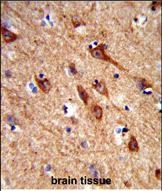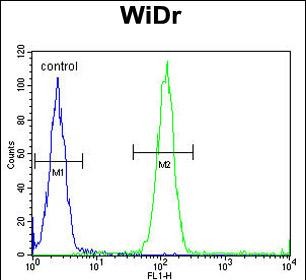ACCN1 Antibody (Center)
Affinity Purified Rabbit Polyclonal Antibody (Pab)
- SPECIFICATION
- CITATIONS
- PROTOCOLS
- BACKGROUND

Application
| FC, IHC-P, WB, E |
|---|---|
| Primary Accession | Q16515 |
| Other Accession | Q62962, Q925H0 |
| Reactivity | Human |
| Predicted | Mouse, Rat |
| Host | Rabbit |
| Clonality | Polyclonal |
| Isotype | Rabbit IgG |
| Calculated MW | 57709 Da |
| Antigen Region | 120-148 aa |
| Gene ID | 40 |
|---|---|
| Other Names | Acid-sensing ion channel 2, ASIC2, Amiloride-sensitive brain sodium channel, Amiloride-sensitive cation channel 1, neuronal, Amiloride-sensitive cation channel neuronal 1, Brain sodium channel 1, BNC1, BNaC1, Mammalian degenerin homolog, ASIC2, ACCN, ACCN1, BNAC1, MDEG |
| Target/Specificity | This ACCN1 antibody is generated from rabbits immunized with a KLH conjugated synthetic peptide between 120-148 amino acids from the Central region of human ACCN1. |
| Dilution | FC~~1:10~50 IHC-P~~1:50~100 WB~~1:1000 E~~Use at an assay dependent concentration. |
| Format | Purified polyclonal antibody supplied in PBS with 0.09% (W/V) sodium azide. This antibody is purified through a protein A column, followed by peptide affinity purification. |
| Storage | Maintain refrigerated at 2-8°C for up to 2 weeks. For long term storage store at -20°C in small aliquots to prevent freeze-thaw cycles. |
| Precautions | ACCN1 Antibody (Center) is for research use only and not for use in diagnostic or therapeutic procedures. |
| Name | ASIC2 (HGNC:99) |
|---|---|
| Function | Forms pH-gated trimeric sodium channels that act as postsynaptic excitatory sensors in the nervous system (PubMed:10842183, PubMed:23034652, PubMed:8626462, PubMed:8631835). Upon extracellular acidification, these channels generate rapid, transient inward currents that fully desensitize (PubMed:10842183). Highly selective for sodium, they are permeable to other cations (PubMed:8626462, PubMed:8631835). By forming heterotrimeric channels with ASIC1, could contribute to synaptic plasticity, learning, and memory. Additionally, as acid sensors at nerve terminals, plays a role in mechanosensation and phototransduction (By similarity). |
| Cellular Location | Cell membrane; Multi-pass membrane protein {ECO:0000269|Ref.10}. Note=Localized at the plasma membrane of neurons, in the soma and punctated peripheral processes {ECO:0000250|UniProtKB:Q925H0} |
| Tissue Location | Expressed in brain, cerebellum, trigeminal sensory ganglia and also detected in testis. |

Thousands of laboratories across the world have published research that depended on the performance of antibodies from Abcepta to advance their research. Check out links to articles that cite our products in major peer-reviewed journals, organized by research category.
info@abcepta.com, and receive a free "I Love Antibodies" mug.
Provided below are standard protocols that you may find useful for product applications.
Background
ACCN1 encodes a member of the degenerin/epithelial sodium channel (DEG/ENaC) superfamily. The members of this family are amiloride-sensitive sodium channels that contain intracellular N and C termini, 2 hydrophobic transmembrane regions, and a large extracellular loop, which has many cysteine residues with conserved spacing. The member encoded by this protein may play a role in neurotransmission. In addition, a heteromeric association between this member and ACCN3 (variant 1) has been observed to co-assemble into proton-gated channels sensitive to gadolinium.
References
Bashari,E., et.al., Am. J. Physiol., Cell Physiol. 296 (2), C372-C384 (2009)
Chai,S., et.al., J. Biol. Chem. 282 (31), 22668-22677 (2007)
If you have used an Abcepta product and would like to share how it has performed, please click on the "Submit Review" button and provide the requested information. Our staff will examine and post your review and contact you if needed.
If you have any additional inquiries please email technical services at tech@abcepta.com.













 Foundational characteristics of cancer include proliferation, angiogenesis, migration, evasion of apoptosis, and cellular immortality. Find key markers for these cellular processes and antibodies to detect them.
Foundational characteristics of cancer include proliferation, angiogenesis, migration, evasion of apoptosis, and cellular immortality. Find key markers for these cellular processes and antibodies to detect them. The SUMOplot™ Analysis Program predicts and scores sumoylation sites in your protein. SUMOylation is a post-translational modification involved in various cellular processes, such as nuclear-cytosolic transport, transcriptional regulation, apoptosis, protein stability, response to stress, and progression through the cell cycle.
The SUMOplot™ Analysis Program predicts and scores sumoylation sites in your protein. SUMOylation is a post-translational modification involved in various cellular processes, such as nuclear-cytosolic transport, transcriptional regulation, apoptosis, protein stability, response to stress, and progression through the cell cycle. The Autophagy Receptor Motif Plotter predicts and scores autophagy receptor binding sites in your protein. Identifying proteins connected to this pathway is critical to understanding the role of autophagy in physiological as well as pathological processes such as development, differentiation, neurodegenerative diseases, stress, infection, and cancer.
The Autophagy Receptor Motif Plotter predicts and scores autophagy receptor binding sites in your protein. Identifying proteins connected to this pathway is critical to understanding the role of autophagy in physiological as well as pathological processes such as development, differentiation, neurodegenerative diseases, stress, infection, and cancer.




